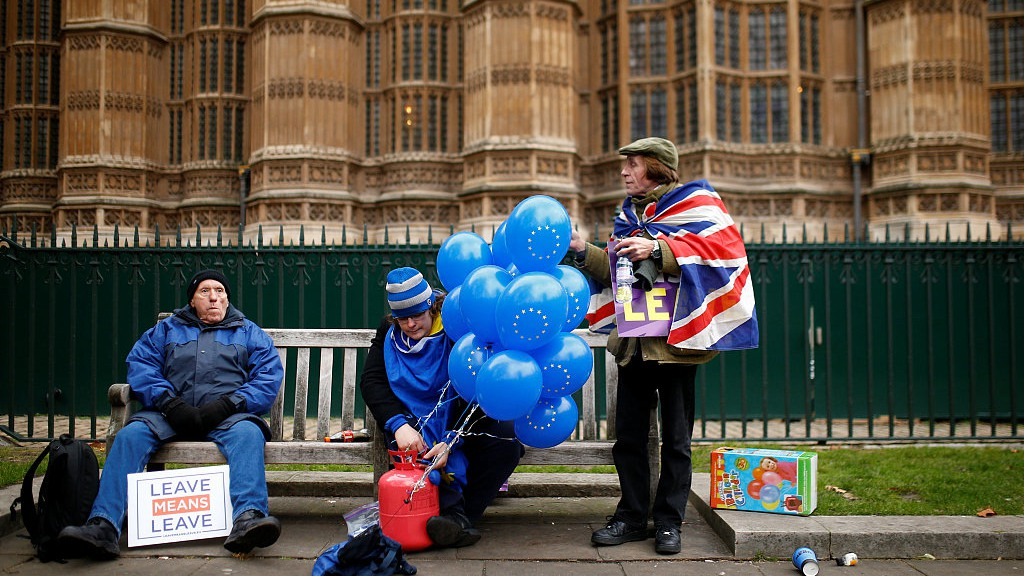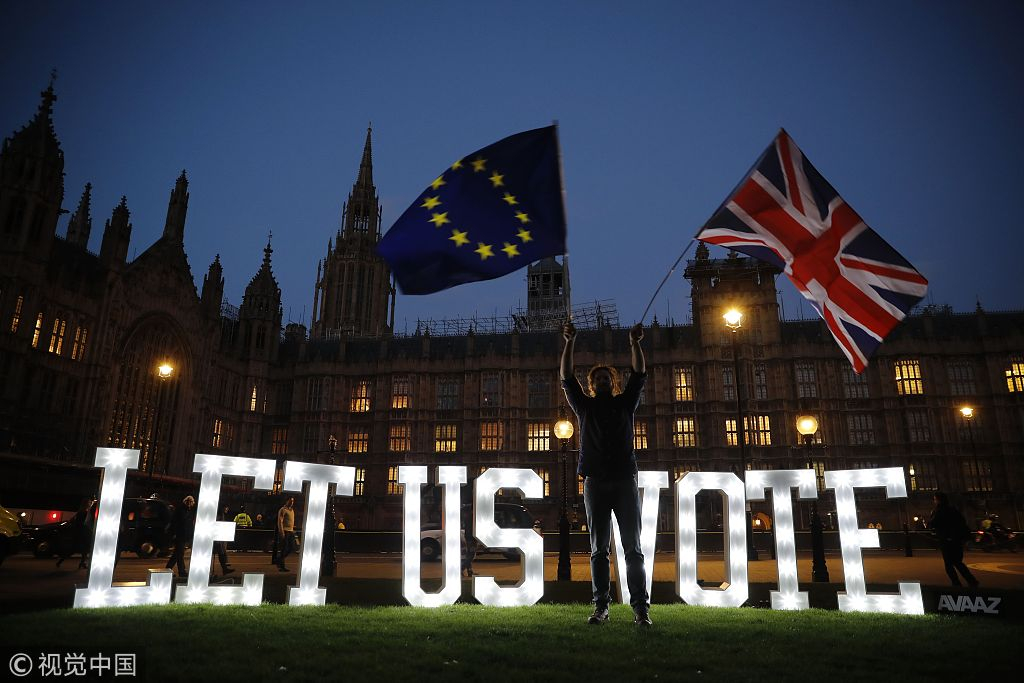
Opinion
16:08, 28-Mar-2019
Britlock - Britain's Brexit Gridlock
Tom Fowdy

Editor's note: Tom Fowdy graduated with an MSc in Chinese Studies from Oxford University after majoring in Politics at Durham University. He has published a number of pieces on the international relations of China and the Democratic People's Republic of Korea. The article reflects the author's views, and not necessarily those of CGTN.
March 27 marked more bad news on the Brexit front. The House of Commons failed to recommend an alternative vision for Britain's terms of departure from the European Union, with seven different motions detailing various options failing to win an agreement from UK lawmakers. In the midst of this, Prime Minister Theresa May promised to resign from her position if MPs finally agree to vote in favor of her agreement with Brussels.
However, none of this is even remotely reassuring. Not only is there significant doubt that the Prime Minister's proposed deal could pass after having been rejected twice, but the broader events also confirm that Westminster is unable to agree on any contingency plans in the wake of the April 12 deadline that Brussels has given them. With the Prime Minister so stubbornly sticking to her proposal, one can only assume that the gridlock is set to continue, even if a no-deal is likely to be avoided. We should expect the UK to remain in limbo and anticipate for European Elections in May.
As noted earlier in the week, Theresa May has long lost control of Brexit. However, Parliament has now missed an open goal by failing to recommend anything else. Despite that MPs defeated the government and forced a series of votes on alternative terms to Britain's departure, the result proved ultimately inconclusive. As much as MPs may as a majority oppose Brexit, this does not mean there is a unified position on what should be done instead.

Britain's Secretary of State for Exiting the European Union David Davis welcomes the European Union's chief Brexit negotiator Michel Barnier to Downing Street in London, February 5, 2018. /VCG Photo
Britain's Secretary of State for Exiting the European Union David Davis welcomes the European Union's chief Brexit negotiator Michel Barnier to Downing Street in London, February 5, 2018. /VCG Photo
Thus, seven motions were struck down. This included 1) A No Deal Departure 2) Unilaterally canceling Brexit 3) A second referendum 4) Leaving the EU but remaining in the customs union 5) Rejoining the European Free Trade organization 6) Renegotiating the current agreement with adherence to the Labour Party's proposals 7) Agreeing with the EU on a period of two years in which UK goods have full access to EU markets.
The demise of these secondary “recommendation” options means now there is only one legitimate “deal” left: Theresa May's option. However, that too is unequally unable to pass the legislative hurdle. The Prime Minister, however, is determined to double down on it. Thus yesterday, she came out and promised her resignation if MPs would pass it. This has made some movement, but not enough. Hardliner Eurosceptic rebels such as Boris Johnson and Jacob Rees-Mogg are now publicly considering supporting it on these grounds.
However, her government partners the Democratic Unionist Party (DUP), whom she is most reliant on to achieve a majority in the Commons, again issued a statement saying they still cannot accept her agreement owing to the long term controversies on the Northern Ireland backstop. Thus, nothing has really changed at all.

An anti-Brexit activist waves the UK and EU flags near the Houses of Parliament in central London, March 27, 2019. /VCG Photo
An anti-Brexit activist waves the UK and EU flags near the Houses of Parliament in central London, March 27, 2019. /VCG Photo
Given this, the deadlock is likely to continue, and Theresa May, as a result, is likely to remain in place. If nothing can be changed regarding her deal, this will see the UK run towards the April 12 deadline on notifying Brussels what they want to do next. Because the Commons has repeatedly struck down a no-deal outcome and Europe doesn't want one either, it is likely the Prime Minister will be forced to submit to a deeper extension of Article 50. Given this, it means the UK will be obligated to take part in the 2019 European Elections scheduled for May, something they were once anticipating to miss out on.
This, of course, is no way forward. With May's unpopular deal the only serious outcome, it thus means the UK will be subject to a state of limbo, locked in Europe without any plan, direction or leadership. By attaching her terms of departure so strictly to the unlikely notion her deal can pass, Theresa May is not solving the problem but prolonging it. The Labour Party is calling for a general election. Jeremy Corbyn is right to note that the status quo cannot offer a way forward, only a new government or a strengthened version of Theresa May's government, for that matter, can force a Brexit deal through. However, it appears the Conservatives see too much risk in doing so, and thus the Prime Minister is keen to avoid it.
So in summary, unless Downing Street can somehow convince a shattered party apparatus and the DUP to force her deal through Parliament, Britain faces a prolonged deadlock, with no Brexit nor for that matter any ability to cancel Brexit either. The Commons ultimately threw away a golden opportunity to recommend a change to the country's direction, in doing so reducing all options to the one they also cannot accept. By tying her job to the success of her deal, Theresa May herself has also chained the UK down. It's a deal that has no hope yet cannot be dropped. Until something changes, it's back to square one again and again and again.
(If you want to contribute and have specific expertise, please contact us at opinions@cgtn.com.)

SITEMAP
Copyright © 2018 CGTN. Beijing ICP prepared NO.16065310-3
Copyright © 2018 CGTN. Beijing ICP prepared NO.16065310-3